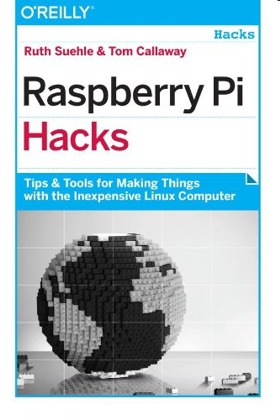| Raspberry Pi Hacks |
|
Author: Ruth Suehle & Tom Callaway A total of 65 Raspberry Pi hacks - surely they have all been done before? Well yes, but that's not the point. This is a really good book and if you want the short version of the review - go and buy a copy, but make sure that you are not a beginner first. If you want a book that shows you how to build simple circuits using big pictures and step-by-step instructions or a book that lists standard Linux commands then you need a different book. However, this said this isn't a super advanced book and it presents its information in a fairly digestible way. There is humour in this book too, but don't expect to fall about laughing. It is also a mix of hardware and software hacks that needs that special blend of knowledge between the two to get the most from the book and the Raspberry Pi. The range of hacks presented is also fairly wide so don't expect to find that every one is useful to you.
The book is divided into six parts. The first part is a collection of 20 configuration hacks. It starts off from basic things like using the right SD card, LEDs, updating the firmware and so on. A large number of the hacks are concerned with how to power the Pi and small hardware mods like adding a reset button. Part 2 is about hacking Linux - and this is mostly not about the basic Linux commands. The first hack is about building a cross-compiler toolchain so that you can move on to the next hack and build a custom Linux Kernel.. It also covers some easier things like emulating the Pi on QEMM, using Occidentalis and running Android on the Pi. Part 3 - Pi Around the House - is a bit more standard fair in that it starts off with how to get Samba running and then how to use the Pi as a remote print server. What you make of the rest of the hacks in this part depends on what you already know - a telephone system; a web server, i.e. installing LAMP; a Lego robot using ROS; an illusion using a camera and screen; and finally how to join Seti@home.
Part 4 - Hacking the Outdoors - is a collection of fairly standard hardware projects - temperature measurement, auto-check on plants watering, making the Pi water-resistance. geocaching, radio, aerial photography and a lights display. Part 5 - Multimedia Hacks - takes you though playing video files, adding codecs, building a music box, radio, adding a touch screen, classic video game console, controlling a DSLR, media center and mobile video player.
The final part - Extend You Pi - has projects to allow you to control the GPIO from a web browser, add a small screen, use Arduino shields, control a 3D printer and add a numeric keypad. How much you get out of this book depends on what you want to do. The parts that were most valuable to me were on the software - especially creating a custom Linux Kernel which really does open up some additional possibilities. The feel of the book is very much "hack" rather than buying off-the-shelf finished units and this makes it so much the better. Highly recommended as long as you are not a complete beginner.
To keep up with our coverage of books for programmers, follow @bookwatchiprog on Twitter or subscribe to I Programmer's Books RSS feed for each day's new addition to Book Watch and for new reviews.
|
|||
| Last Updated ( Friday, 21 September 2018 ) |

